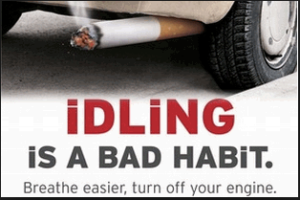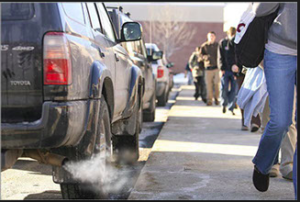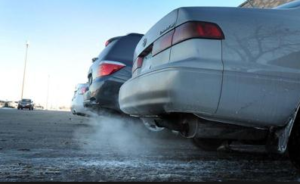Driving a vehicle causes polluting emissions that create health risks and acerbates climate changes. But idling the vehicle can be just as destructive.
Public Health England (PHE), an Executive agency and part of the UK Department of Health and Social Care, recently published a Review of interventions to improve outdoor air quality and public health. The report covers a range of threats from and interventions to prevent or reduce the impacts from air pollution. PHE reviews the existing data and findings that exposure to air pollution contributes to about 36,000 deaths in the UK each year, often from cardiovascular disease, respiratory disease and cancers. It also notes that there is emerging evidence of the links between air pollution and conditions like diabetes, the underdevelopment of infant lungs and cognitive decline.
Eliminating the sources of the pollutants in the first place, e.g., through electric vehicles, certainly is critical. As is reducing the concentration of pollutants, e.g., through low emission vehicles. But it is also necessary to determine which interventions can reduce actual exposure to the air pollutants that will continue to put the public at risk.
The report covers interventions in a variety of sectors, including agriculture, planning and industry, and especially transport. There are numerous interventions but we will focus on just one in transport: anti-idling. It is a useful, uncomplicated, and inexpensive initiative that has immediate effects.
However, it does require behavioral changes, which is always challenging. The behavioral changes involve educating the driving, and larger public, about the dangers of idling: the carrot. But changes to idling behavior also require the stick: laws to control idling and effective penalties when drivers continue to idle.

An advantage for measures to control idling is that they can be focused on hot spots of pollution near vulnerable populations, e.g., schools, hospitals and care facilities. This last point is stressed by the PHE and of course makes sense.
Picking students up at school often leads many parents or caretakers to sit idling their vehicles while waiting for their riders, and that concentrates polluting emissions. Those emissions are compounded by a fleet of school buses that idle while waiting to load students. Dropping students off at school most often involves less idling, but of course any regulation should apply to any idling near the schools, as well as hospitals or care facilities.

One of the weaknesses of the report is that it seems to dump many interventions onto local authorities. It notes in passing that local interventions need support from consistent national policies, but the report concentrates on interventions at the local level, including for anti-idling measures.
Local authorities are well positioned for enforcement of anti-idling laws since they typically have other responsibilities for traffic and parking, and idling is closely related. At the same time national governments can participate in this pollution-prevention initiative by prescribing the terms of idling behavior: which vehicles are covered, which places are affected, and for what length of time is idling permitted and banned.
A combination of a nationally-applicable idling standard and local enforcement, using existing traffic staff, offers a sensible way to address a serious air pollution problem.
Rules and regulations in New York offer an instructive example of the scope and possible structures of rules and enforcement on idling. New York City (NYC) and New York State each has restrictions on the length of time that a vehicle engine may lawfully idle. Under the New York City Air Code, applicable throughout the five boroughs of New York City, motor vehicle engines may lawfully idle for no more than 3 minutes, and only for 1 minute if adjacent to a school. N.Y.C. Admin. Code § 24-163. The New York State Air Code, applicable throughout the State (including New York City), limits the lawful idling of only heavy duty vehicle engines to 5 minutes. 6 N.Y.C.R.R. § 217-3.2.
Under state regulations, liability for idling rests not only on the owner or driver of the truck, but also on anyone “who owns, leases, or occupies land and has the actual or apparent dominion or control, over the operation of a heavy duty vehicle including a bus or truck present on such land …”. 6 NYCRR § 217-3.2 Thus, tickets for idling can be issued to the owner or developer of the site where idling is occurring, e.g., a construction site, which is a more efficient enforcement approach than issuing tickets to individual truck drivers.

Violations of either idling restriction give rise to civil penalties and may subject the owner and operator of the vehicle to a lawsuit. For example, penalties for violating the New York State Air Code range from $500 to $18,000. Each law has exceptions to the ant-idling laws, including an exception in the State law for electric powered vehicles.
The NYC law is enforceable by the New York City Department of Environmental Protection (DEP), the New York Police Department (NYPD), including the Traffic Officers responsible for issuing parking tickets, as well as by the department of parks and recreation and the department of sanitation. Most enforcement is by staff at the DEP. New York State enforces its idling laws through the State’s Department of Environmental Conservation, which has its own police or conservation officers. Enforcing idling laws is undertaken along with their other duties, and additional staff and training are not required.
The New York structure for idling regulations and enforcement is simply an example of some possibilities for controlling the toxic fumes from idling vehicles. Certainly it could be more efficient to have one regulation applied across a Member State, with enforcement at the local level by existing traffic wardens, without significant additional resources or training.
Idling wastes fuel and costs money, and controlling it brings health and environmental benefits. At the same time, local authorities can generate income from idling fines, as they do from parking fines, helping to offset any regulatory costs.
Sources:
Public Health England, Review of interventions to improve outdoor air quality and public health (March 2019). bit.ly/2XgUniU
Matthew Weaver, “Ban cars from idling near schools, says UK public health agency,” The Guardian (11 March 2019). bit.ly/2F5qe00
Environmental Defense Fund, Attention drivers! Turn off your idling engines (2009). bit.ly/2PXvvt8
NEW YORK CITY ADMINISTRATIVE CODE. TITLE 24, ENVIRONMENTAL PROTECTION AND UTILITIES. CHAPTER 1: AIR POLLUTION CONTROL. Section 24-163 at page 33-34. on.nyc.gov/2Izsr6E
State of New York, Codes, Rules and Regulations (NYCRR), Title 6 Department of Environmental Conservation, Subpart 217-3 “Idling Prohibition for Heavy Duty Vehicles.” bit.ly/2UQDfnF


No comments yet, add your own below